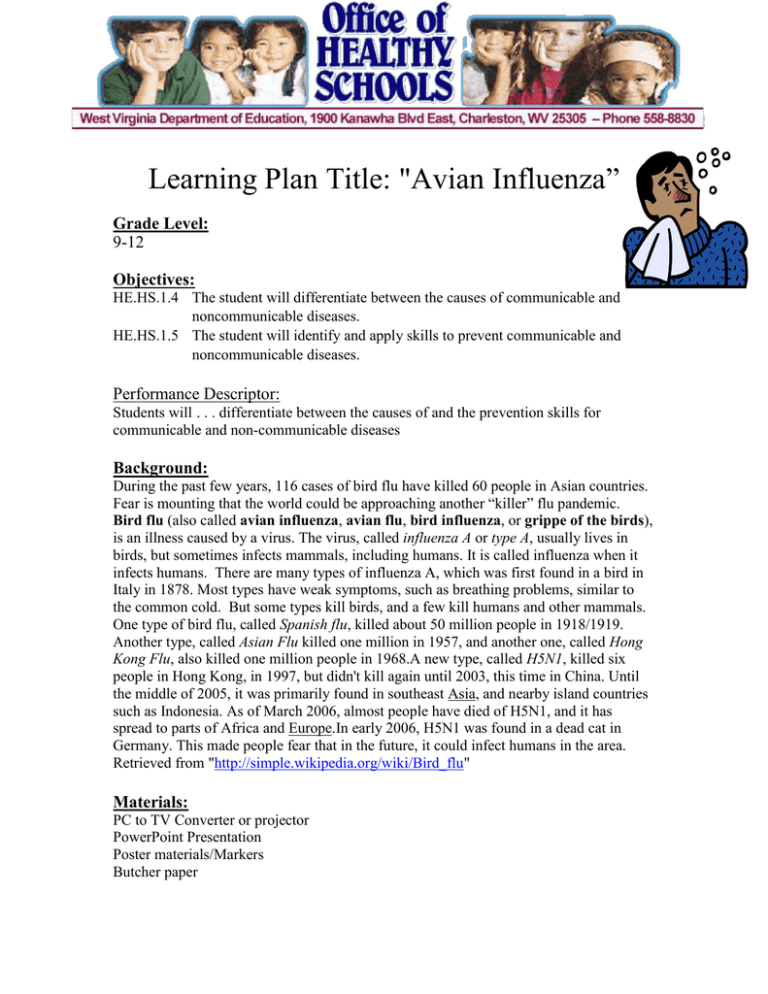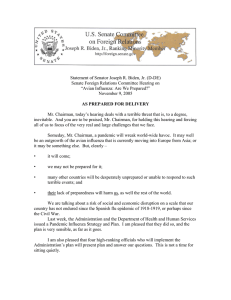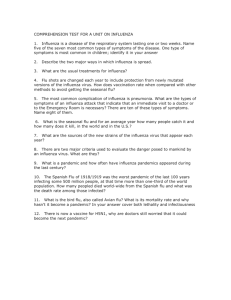Learning Plan Title: "Avian Influenza” Grade Level: Objectives:
advertisement

Learning Plan Title: "Avian Influenza” Grade Level: 9-12 Objectives: HE.HS.1.4 The student will differentiate between the causes of communicable and noncommunicable diseases. HE.HS.1.5 The student will identify and apply skills to prevent communicable and noncommunicable diseases. Performance Descriptor: Students will . . . differentiate between the causes of and the prevention skills for communicable and non-communicable diseases Background: During the past few years, 116 cases of bird flu have killed 60 people in Asian countries. Fear is mounting that the world could be approaching another “killer” flu pandemic. Bird flu (also called avian influenza, avian flu, bird influenza, or grippe of the birds), is an illness caused by a virus. The virus, called influenza A or type A, usually lives in birds, but sometimes infects mammals, including humans. It is called influenza when it infects humans. There are many types of influenza A, which was first found in a bird in Italy in 1878. Most types have weak symptoms, such as breathing problems, similar to the common cold. But some types kill birds, and a few kill humans and other mammals. One type of bird flu, called Spanish flu, killed about 50 million people in 1918/1919. Another type, called Asian Flu killed one million in 1957, and another one, called Hong Kong Flu, also killed one million people in 1968.A new type, called H5N1, killed six people in Hong Kong, in 1997, but didn't kill again until 2003, this time in China. Until the middle of 2005, it was primarily found in southeast Asia, and nearby island countries such as Indonesia. As of March 2006, almost people have died of H5N1, and it has spread to parts of Africa and Europe.In early 2006, H5N1 was found in a dead cat in Germany. This made people fear that in the future, it could infect humans in the area. Retrieved from "http://simple.wikipedia.org/wiki/Bird_flu" Materials: PC to TV Converter or projector PowerPoint Presentation Poster materials/Markers Butcher paper Learning Plan: Present a short lesson on viruses, emphasizing influenza. Before beginning with the group assignment, show a video on viruses 1. Divide the class into four groups and give each group an assignment to research and present. The time factor will depend on group dynamics, materials available and library/internet access. This may need to be a two day lesson. 2. 3. 4. Group 1: Research past influenza pandemics in the U.S. and world. Include influenza outbreaks since 1918. Provide data of morbidity. Using today’s population, calculate the percentage of death compared to those who died in 1918. Compare and contrast methods and speed of transmission of the 1918’s influenza pandemic to one if it occurred today. Group 2: Research prevention measures for pandemics. List public health guidelines for disease prevention. What can the public do to help prevent a pandemic? Prepare the CDC’s “School District (K-12) Pandemic Influenza Planning Checklist” for the groups to complete. Determine what students can do to help prevent the spread of influenza? Group 3: Investigate intervention strategies in the event of an avian flu pandemic Discover what methods of intervention are used today to combat this avian flu. List and describe the medications/immunizations are available for avian flu? If there would be a pandemic, what role will uninfected persons play in the treatment of those infected? Group 4: Consider the effects of an avian flu pandemic on society. (public works, healthcare, homeland security, food supply, energy requirements, government, the dead) Create a detailed newspaper article as if an avian flu pandemic was really happening and describe life events now (points to consider: marshall law? Supply lines, disposal of bodies, etc. Groups will report out to the class. They should include a PowerPoint presentation, posters, butcher paper, or some other form of AV in their presentation to the class. Each group will create five multiple choice questions. Combine the questions and administer a quiz to the entire class. While discussing the answers, have each group explain their questions. Suggested Videos: Body Story: The Flu (Discovery Health Connection) Life Science: Viruses (Discovery Health Connection) Online Video Sources: http://abcnews.go.com/Health/AvianFlu/ Avian Flu PowerPoint Additional Avian Flu Links: http://www.cdc.gov/flu/avian/ http://www.pandemicflu.gov/ http://www.msnbc.msn.com/id/12373026/ http://news.yahoo.com/fc/Health/Bird_Flu http://www.who.int/csr/resources/publications/influenza/WHO_CDS_CSR_GIP_05_8EN.pdf Online Learning Plans http://www.nytimes.com/learning/teachers/lessons/20060328tuesday.html?searchpv=lear ning_lessons http://avianflu.futurehs.com/?p=1714 http://www.pbs.org/newshour/extra/teachers/lessonplans/health/birdflu_projectguide2.pdf http://www.upd8.org.uk/activity/165/AviFlu-is-coming.html http://www.pbs.org/wnet/secrets/case_killerflu/clues.html http://www.pbs.org/wnet/secrets/lessons/lp_virus.html Cross Curricular Learning Plans: English: http://www.usingenglish.com/handouts/advanced/bird-flu.pdf Biology: http://www.bioedonline.org/slides/slide01.cfm?tk=34 Social Studies: http://www.classbrain.com/artteensb/publish/bird_flu_pandemic.shtml Math: http://online.wsj.com/public/article/SB110512998255120225.html?mod=todays_free_fea ture





